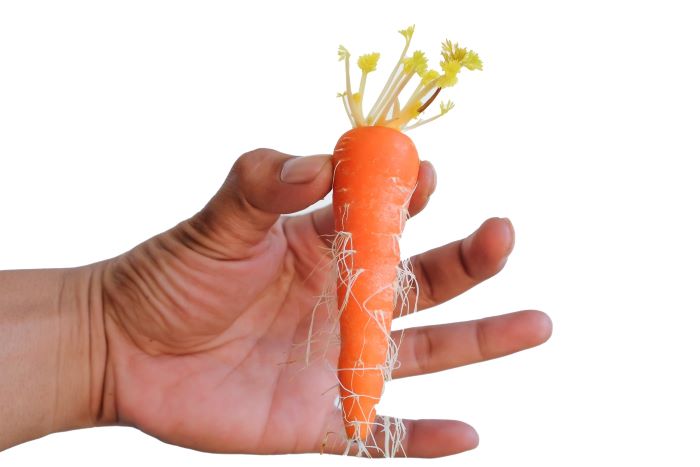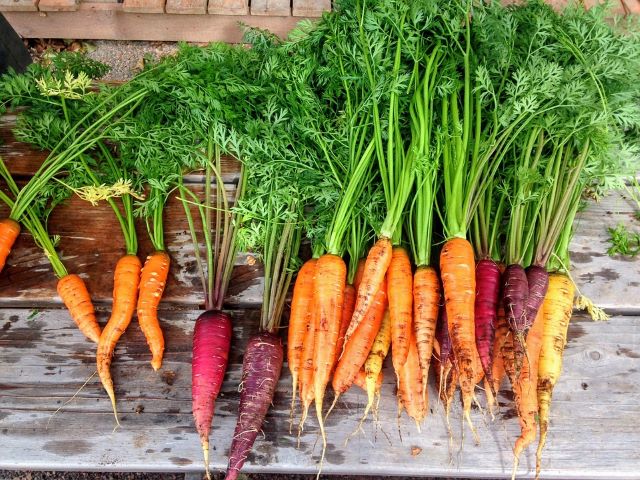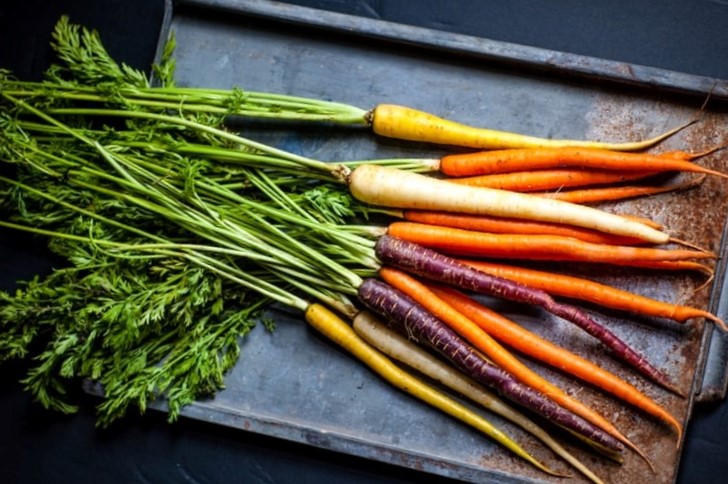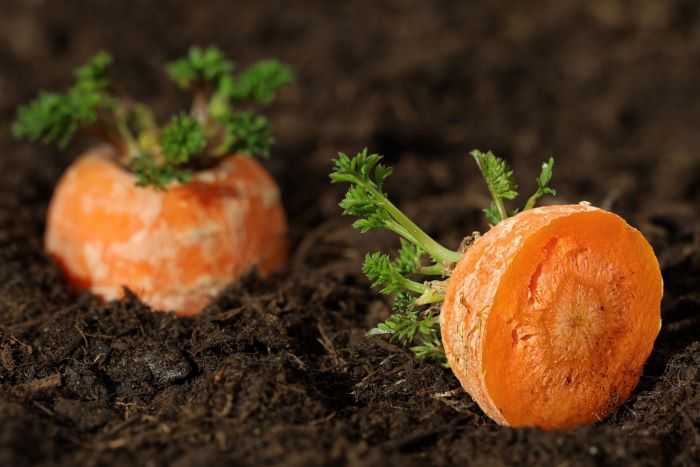Carrots are usually sweet, crunchy vegetables that can be eaten raw or cooked. But what happens when your carrots start growing? Can you eat carrots that have sprouted roots? How are they different from other carrots? And what about carrots that have sprouted greens? Read on to find out.

Sprouted carrots are safe to eat. They do not contain any toxins, but if the carrots are sprouting roots, their texture may become very rubbery and may be slightly bitter because the sugars are being used. If your carrots are sprouting carrot greens, these are edible too and resemble the flavor of other green, leafy vegetables like kale.
Table of Contents
Why Do Carrots Sprout?
Carrots are root vegetables. They grow underground and use their sprouted offshoots to store carbohydrates, also known as sugars, that they have converted into starch.
Just because a carrot is out of the ground doesn’t mean it stops growing entirely. Instead, in an effort to keep surviving, the carrot will continue to grow roots and green leaves to continue surviving.
There are a couple of different factors, such as light, moisture and age, which encourage this sprouting. This means it is important to store your carrots correctly to prevent sprouting.
You are more likely to experience sprouting carrots when they are organic, purchased from a farmers market, or from those you have grown yourself.
This is because commercially grown carrots are often sprayed with a growth inhibitor specifically to stop them from growing. For commercial growers, this means the carrots will store longer during transportation and once they reach the grocery store shelves.
Can You Eat Carrots That Have Sprouted Roots?
Yes, you can still eat carrots with spouted roots. There is nothing wrong with them. Sprouted carrots are still edible and do not contain any toxins, but you may notice they are not as sweet as they were before. This lack of sweetness can sometimes taste a little bitter.
Additionally, the carrots may become rubbery. Though the fact that carrots lose moisture as they age plays a role in this rubbery texture.
Eating too Many Sprouted Carrots
There is no such thing as eating too many sprouted carrots. However, if you always eat carrots, regardless of whether they are sprouted or not, your skin may turn slightly orange.
This is called Carotenemia, and happens because the orange pigment in the carrot – beta-carotene – usually converted to vitamin A, can accumulate in the skin.
Ways to Eat Sprouted Carrots

Even though sprouted carrots are still edible, many people end up throwing them away because of an aversion to the texture or appearance. However, there are some things that you can do to make them more delicious to eat.
Juice Carrots
Juicing carrots removes the issue of texture entirely. Even if you like your carrot juice with a fair amount of pulp, the very small pieces will not be nearly as noticeable as in other dishes.
And perhaps mix your carrot juice with other flavors. Here are a few classic and unusual examples to juice your carrots with:
- Carrot, Apple and Ginger
- Orange, Carrot and Ginger
- Apple, Carrot, Ginger and Beets
- Carrot, Apple, Celery and Kale
- Carrot and Pineapple
- Cucumber, Carrot and Apple
Stir Fry Carrots with Other Vegetables
Stir-frying sliced carrots soften them up a great deal. In order to make up for the slight difference in flavor, stir-frying them with other vegetables is a great option.
Caramelize Your Carrots
Caramelizing your carrots will make them taste sweeter. This can be done in a pan or in the oven. If you are uncertain, consider caramelizing them with onions, so the sweet onion flavor contributes to the carrots.
Bake a Carrot Cake
Carrot cake involves a variety of other ingredients. This means that, even though the carrots contribute a great deal to the flavor, there are small adjustments that can be made in the sugar and moisture levels of the recipe to make up for variations in the carrot.
How to Prevent Sprouting Carrots?
Crunchy, sweet carrots are definitely better than carrots that have started growing roots and become rubbery. So how do you prevent sprouting?
Keep Carrots Cold
Carrots last a surprisingly long time in the fridge. A couple of months at a time, depending on how long they were on the shelf when you bought them.
Even though you may think your carrots are safe in the fridge, some places there are colder than others. What is essential is keeping your carrots as cool as possible.
So, try to keep them at the back of your refrigerator, and make sure any leftovers are cool before placing them in your fridge.
If you want to store your carrots pre-sliced, place them in a container of water, making sure they are entirely covered. The water should be replaced every few days but will allow your carrots to last up to a week.
Alternatively, you can freeze your carrots. This is the best option if you want them to last a really long time. I recommend cutting them into slices, chunks, or whatever you think you will use first. Then blanch them and allow them to cool before freezing.
Theoretically, they can last an entire year if frozen. But that depends on a lot of factors, such as how old they were when they went into the freezer.
Dry Carrots
Moisture is one of the biggest factors that initiates sprouting. Make sure that you dry your carrots thoroughly. But, if you want to take it a step further, consider dehydrating them.
You could precook your carrots before dehydrating and then add them to meals several minutes before your dish is done to allow them to absorb moisture. Or you can dehydrate them raw. Remember that you will need to account for additional cooking time when dehydrating them.
Store dehydrated carrots properly, especially if you live in humid conditions. Dehydrated carrots keep best in airtight containers or jars and stored in a cool dark pantry.
Pickle or Brine Carrots
Pickling or brining carrots is a great way to store them and makes a delicious snack.
Pickling most often refers to storing your carrots in a solution of sugar and vinegar. The low pH and the altered osmolarity of the liquid prevent bacteria and fungi from growing.
But bringing them in salt is also an option. The salt also slows the growth of bacteria. Which one you choose is a case of personal flavor preference.
Carrots Sprouting Greens
Now let’s talk about carrots that start resprouting their greens. What does this do to the orange part of the carrot?
Not much. This growth is often caused by storing the carrots somewhere with too much light. But it does not change much about the root that you’ll notice when eating.
Carrot Greens Are Edible

Carrot greens can be eaten! And they are a great way to reduce your food waste. The carrot greens taste similar to parsley and can be used in a variety of ways – check out our article Eating Carrot Tops With Recipe Ideas.
They can also be on the bitter side but no more so than other bitter greens, such as kale.
You can harvest carrot greens without pulling your carrots out of the ground if you are growing them yourself.
Storing Carrot Greens
If you find yourself with carrot greens, cut them off your carrot as close to the top as you can. Afterward, you can wash them, dry them with a salad spinner, and store them in the fridge or freezer.
These stay good for quite a while. It’s quite easy to keep them fresh for a week or two. If you notice they start getting slimy, they have probably gone bad.
Preparing Carrot Greens
How do you cook carrot greens? It is rather simple. Just cook them as you would any other green leaf.
Consider blanching them in boiling water until the color brightens, or use them to make crispy potato chip alternatives in an air fryer.
Can You Regrow Sprouted Carrots?

Yes! You can regrow your sprouted carrots but only the carrot greens will grow, not the carrot taproot.
The easiest way to regrow your carrot greens is to cut the tops off the carrot about 1/2 an inch from the top. them and plant the sprouted green parts.
Place your carrot tops, cut side down, in a shallow water dish submerging about half the carrot piece. You can also start them on a wet paper towel though you will need to keep the paper towel continually wet so I recommend the dish option. Then sit back and observe how the carrot greens grow!
Planting them directly into the soil works as well. But starting with indoor pots might be easier because you can control the moisture and sunlight levels with more accuracy.
This is a great option for growing carrot greens quickly and a fun thing to do with kids who will be fascinated by watching carrot tops sprout!
Identifying Spoilt Carrots
So carrots that have started growing are fine to eat. What isn’t? When is it time to throw your carrot out?
If there are any dark spots on your carrot, they may be suffering from root rot or a kind of fungus. It is often safer to throw these out. Likewise, any moldy carrots or those that have gone squishy and slimy should be avoided.
If I am unsure, I peel my carrot and decide based on what it looks like underneath. Sometimes the issue is only on the skin. If it seems to go deeper, it goes into the compost.
Related Reading:
